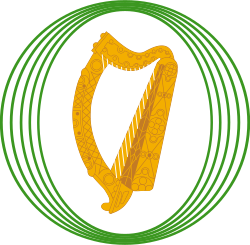Dáil Éireann
Dáil Éireann (/dɔɪl ˈɛərən/ (![]() listen)[2] literally Assembly of Ireland) is the lower house of the parliament of Ireland. Its members are elected by all Irish citizens of voting age (which is now 18). Members of Dáil Éireann are called Teachta Dala (TD).
listen)[2] literally Assembly of Ireland) is the lower house of the parliament of Ireland. Its members are elected by all Irish citizens of voting age (which is now 18). Members of Dáil Éireann are called Teachta Dala (TD).
Dáil Éireann Assembly of Ireland | |
|---|---|
| 33rd Dáil | |
 | |
| Type | |
| Type | of the Oireachtas |
| Leadership | |
| Structure | |
| Seats | 160 |
 | |
Political groups | Government (84)
Opposition (75)
|
| Elections | |
| Single transferable vote | |
Last election | 8 February 2020 |
Next election | No later than 20 February 2025 |
| Meeting place | |
 | |
| Dáil chamber Leinster House, Dublin | |
| Website | |
| oireachtas | |
History
First Dáil
The First Dáil was elected at the British General election of 1918. The Sinn Féin people who were elected did not go to the House of Commons. Instead they stayed in Dublin and set up the First Dáil.
The First Dáil passed the Declaration of Independence of the Irish Republic, a Constitution, and set up a government.
The first British woman MP was Countess Markiewicz. Because she was a Sinn Féiner, she went to the first Dáil Éireann instead. That is why many people think Lady Astor was Britain's first woman MP.
Second Dáil
In 1922, during the War of Independence, the British passed the Government of Ireland Act. The act set up two parliaments, one for Northern Ireland and one for Southern Ireland. There was no election in Southern Ireland because only Sinn Féin candidates stood.[3] They did not meet as the House of Commons of Southern Ireland. Instead they, and the only Sinn Feiner elected only in Northern Ireland[4] met as the Second Dáil.
On the first day of the Second Dáil Éamon de Valera, President of the Irish Republic, said there would be no need to fight or negotiate with Britain if the British prime minister remembered that he had said [5]
Poland has chosen her own Government by universal suffrage, and it is intolerable that any country from outside should come in and impose upon her a Government which she does not want.
De Valera said that if Poland had the right to its own government, so did Ireland.
The Second Dáil ratified (that is, confirmed) the Anglo-Irish Treaty, by a vote of 64 to 57. After this the 64 pro-treaty members met as the House of Commons of Southern Ireland, with the four University MPs, and voted to accept the treaty again.
Third Dáil
The Third Dáil was two things.
- The pro-independence Dáil, following on from the First and Second Dáils, and
- The Provisional Parliament, following on from the House of Commons of Southern Ireland
The Third Dáil passed the constitution of the Irish Free State, and after 6 December 1922, it was the lower house of the Oireachtas of the Irish Free State.
Dáil Debates
The official record of everything said in the Dáil is called English: [Dáil Debates] Error: {{Lang}}: text has italic markup (help) or Irish: Díospóireachtaí Dála. Volume (book) one starts on the day the Third Dáil met, so the record of the First Dáil is called Book F, and the Second Dáil starts with book S.
Election of the Dáil
TDs are elected in multi-member constituencies, unlike the British House of Commons or the American House of Representatives, which are single-member constituencies. There can be three, four, or five TDs in each constituency. Voters can vote for as many candidates as they want, but they rank them in order of preference, 1,2,3...
Working out who has been elected can sometimes take two or even three days, because the votes are counted several times under the Single Transferable Vote system.
If the Chairman of Dáil Éireann, called the Ceann Comhairle, wants to stand for re-election he is does not have to be elected. The law and the constitution say that he is given a seat in his old constituency.
Powers of Dáil Éireann
The Dail is the more powerful of the two Houses of the Oireachtas.
The Taoiseach, (Prime Minister), the Tánaiste (deputy prime minister) and the Minister of Finance must be members of Dáil Éireann.[6]
Bills to raise tax have to start in the Dáil, and cannot be vetoed by the Seanad.
The Dáil can pass a bill even if the Seanad objects, but the Supreme Court can decide that the act is not allowed by the Constitution. The President can also ask the Supreme Court if the bill is not allowed by the constitution before he/she signs it.
Dáil Éireann Media
Leinster House in Dublin, seat of Dáil Éireann.
Related pages
References
- ↑ "Dublin TD Joan Collins leaves I4C to found new party Right to Change". The Times. 31 May 2020.
- ↑ "Dáil: definition of Dáil in Oxford dictionary (British & World English). Meaning, pronunciation and origin of the word". Oxford Language Dictionaries. Oxford University Press. 2013. Archived from the original on 24 September 2015. Retrieved 30 November 2013.
- ↑ Except for the 4 seats for Trinity College Dublin, where only Independent Unionists stood
- ↑ Sinn Fein won six seats in the Northern Ireland Parliament, but five already had seats in Southern Ireland, so there was only one extra person
- ↑ "Parliamentary Debates 16 August 1921". Archived from the original on 19 November 2007. Retrieved 6 October 2007.
- ↑ Irish Constitution, article 28.7.1
